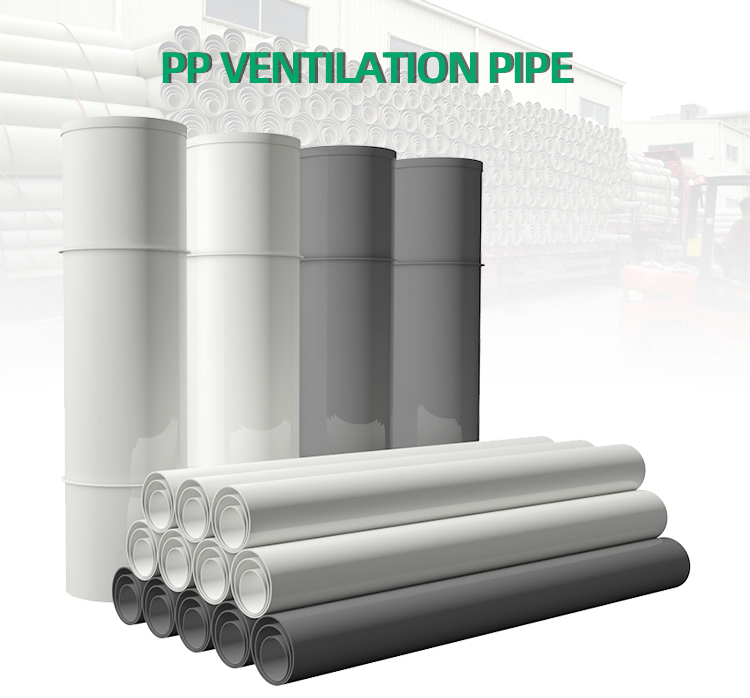There are many ways to process PP plastic ventilation pipe to form various products such as films, sheets, pipes, and profiles. And it’s easy to cut, glue, and “weld”. Plastic is easy to color and can be made into various bright colors; it can also be processed by printing, electroplating, printing, and embossing, so that plastic has a rich decorative effect.
Compared with metal materials, polypropylene PP air ducts have higher corrosion resistance to acids, alkalis, salts, etc. They are especially suitable for chemical plants, chemical laboratories, large shopping malls, schools, etc. Polypropylene PP plastic also has excellent resistance to environmental water and low water absorption, which can be widely used in waterproof and moisture-proof projects.

PP plastic ventilation pipes are not resistant to high temperatures. They generally soften and deform when subjected to loads at high temperatures. The heat distortion temperature of ordinary thermoplastics is 60-120°C, and only a small number of them can be maintained at about 200°C for a long time. PVC plastic is easy to catch fire or burns slowly and will produce a lot of toxic fumes when burning. If a fire occurs, it will cause great losses. Polypropylene PP plastic has strong chemical stability, is non-toxic, harmless, and does not produce harmful gases when burned. PP plastic pipes and PP sheets with flame retardants have flame retardant properties and are widely used.
1. No corrosion: PP plastic ventilation pipe can withstand high-concentration acid-base corrosion with a pH value of 1-14 in a wide temperature range.
2. Anti-wear and no scaling: PP pipes and fittings have smooth inner walls, small flow resistance, and no scaling.
3. Vibration and noise reduction: PP air duct has excellent sound insulation performance, which can significantly reduce vibration and noise caused by liquid flow.
4. Frost crack resistance: PP material has good elasticity, so that the cross-section of the pipe and pipe fittings expand with the frost heave liquid without cracking.
5. Anti-condensation and small heat dissipation: PP air duct is a poor heat conductor, which can reduce condensation and heat loss.
6. Easy installation: PP air duct is light in weight, easy to install and operate, and can be welded.
7. Long service life: Under the specified conditions of use, the service life of the PP air duct system can reach 50 years.
8. Good wear resistance – when conveying mortar, the wear resistance of the PP air duct is more than 4 times that of steel pipe.
9. Good hygienic performance – PP air duct only contains carbon and hydrogen, is non-toxic and tasteless, and has reliable hygienic performance.
10. Reliable connection performance: The strength of the thermally welded joint of the PP air pipe is higher than that of the pipe body, and the joint will not be broken due to soil movement or load.
With the development of the pipe fitting industry, more and more new pipes are being used by people, and PP pipes are also very popular, which also promotes the development of pipe manufacturers. In fact, manufacturers will encounter many problems when producing pipes, such as the rough outer surface of the pipe, traces of grooves on the outer surface, and jitter rings in the pipe. How to solve these problems? Let’s take a look.
1. Outer surface.PP plastic ventilation pipes are relatively rough. Adjust the process temperature and reduce the cooling water temperature. The best cooling water temperature for PE pipe is 20 ~ 25℃. Check whether the waterway is blocked or the water pressure is insufficient. Check whether the heating ring of the barrel, die, etc. is damaged, adjust the water flow of the sizing sleeve, check the performance and batch number of the raw materials, and check the core temperature of the mold. If it is higher than the temperature of the mold section, reduce the core temperature and clean the aggregate of the mold.
2. Grooves will appear on the outer surface of the PP plastic ventilation pipe. Adjust the water outlet pressure of the sizing sleeve, and the water output must be balanced. Adjust the nozzle angle in the vacuum setting box to cool the pipe uniformly. Check the mold, sizing sleeve, cutting machine, and other hardware for debris and burrs.
3. The groove appears on the inner surface. Check whether water enters the inner tube. If it is flooded, pinch the tube blank of the rigid mold to seal its cavity, reduce the internal temperature of the mold, and clean and polish the mold.
4. A jitter ring appears in the pipeline. adjust the sizing sleeve to make it even, and adjust the vacuum of the second chamber to make the vacuum of the back chamber slightly higher than that of the front chamber. Check whether the vacuum seal is too tight, check whether the tractor is shaking, and check whether the output of the main engine is uniform.
5. When there is no vacuum. check whether the water inlet of the vacuum pump is blocked, and unblock it when it is blocked. Check whether the vacuum pump is working properly, check whether the vacuum pipeline is leaking, and check whether the small hole in the middle of the pressure core screw is blocked. If it is clogged, clean it with a thin wire.